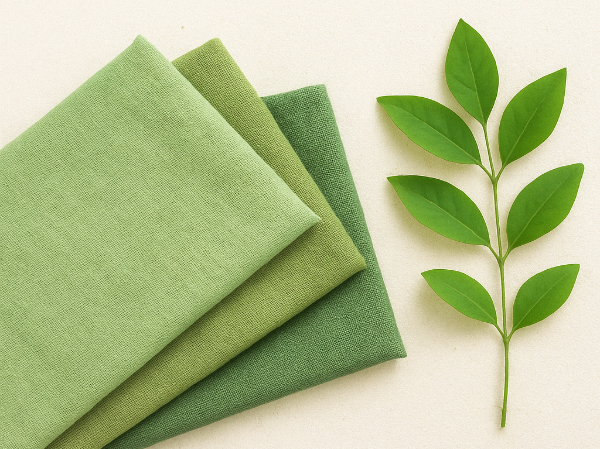Greener Fabrics: Transforming the Textile Industry Towards a Sustainable Future
How Eco-Friendly Textiles Are Revolutionizing Fashion and Saving the Planet

Greener fabrics” refer to textiles that are produced with minimal environmental impact. They prioritize sustainability, ethical production, and circularity over mass consumption and waste. Unlike conventional fabrics made with synthetic fibers and chemical-heavy processes, greener fabrics rely on renewable, recycled, or biodegradable materials that reduce carbon emissions, conserve water, and limit harmful chemicals.
The term doesn’t just describe a product — it reflects an entire philosophy of responsible production and conscious consumerism. Greener fabrics are designed to protect the planet’s ecosystems while maintaining the quality, comfort, and durability that modern consumers demand. They embody the global movement toward sustainable fashion and eco-conscious living.
Why the World Needs Greener Fabrics
Every year, millions of tons of plastic and textile waste are dumped into landfills or end up polluting our oceans. The fashion industry alone contributes nearly 10% of global carbon emissions and consumes enormous amounts of water and energy. Conventional cotton farming uses pesticides that degrade soil and threaten biodiversity, while synthetic fibers like polyester release microplastics into waterways.
This is where greener fabrics come in. Their mission is to reverse this cycle of destruction by introducing materials and manufacturing techniques that protect the environment. For instance, fabrics made from recycled plastic bottles (RPET), organic cotton, bamboo, or hemp drastically reduce waste and pollution. The focus is on circular fashion — reusing, recycling, and regenerating rather than discarding.
Choosing greener fabrics is no longer a luxury; it’s a necessity. As consumers grow more aware of their environmental impact, the demand for sustainable materials continues to rise. Brands that adopt greener practices not only reduce their ecological footprint but also earn consumer trust and loyalty.
The Evolution of Greener Fabrics
The idea of using sustainable materials isn’t new. Historically, natural fibers like linen, wool, and silk dominated the textile world. However, with the rise of industrialization, synthetic fibers such as polyester, nylon, and acrylic became more popular due to their low cost and versatility. Unfortunately, these materials are petroleum-based and non-biodegradable, leading to long-term environmental harm.
In the past decade, growing awareness of climate change and pollution has sparked a revolution in fabric innovation. Greener fabrics have evolved from niche products into mainstream essentials. Today, we see large fashion houses and textile manufacturers investing in green technology — from using algae-based dyes to developing biodegradable synthetic fibers.
The modern consumer now demands transparency, traceability, and responsibility. This push for accountability has made greener fabrics a driving force in reshaping global textile production.
Types of Greener Fabrics and Their Benefits
Organic Cotton
Organic cotton is grown without harmful pesticides, fertilizers, or genetically modified seeds. It supports soil health and conserves biodiversity while requiring less water than conventional cotton. Clothes made from organic cotton are breathable, soft, and hypoallergenic — making them a favorite among sustainable brands.
Hemp Fabric
Hemp is one of the most sustainable fibers on Earth. It grows rapidly without pesticides, requires minimal water, and enriches the soil with nutrients. Hemp fabric is strong, durable, and naturally resistant to mold and UV rays. It’s ideal for clothing, upholstery, and even industrial applications.
Linen
Derived from the flax plant, linen is another eco-friendly champion. It’s biodegradable, long-lasting, and becomes softer with every wash. Linen’s cultivation has a low environmental impact, as the flax plant thrives in poor soil and uses minimal irrigation.
Bamboo Fabric
Bamboo grows quickly and regenerates naturally, making it a renewable resource. When processed mechanically (not chemically), it produces soft, breathable, and moisture-wicking fabrics. Bamboo also absorbs more carbon dioxide than most plants, making it an environmental powerhouse.
Tencel (Lyocell)
Tencel, a branded form of lyocell, is produced from sustainably sourced wood pulp — often eucalyptus. Its closed-loop manufacturing system recycles over 99% of the solvents used. The result is a silky-smooth, durable, and biodegradable fabric that’s ideal for fashion and home textiles.
Recycled Polyester (RPET)
Perhaps the most impactful greener fabric in combating plastic waste is recycled polyester. Made from post-consumer plastic bottles, RPET reduces landfill waste and limits dependency on fossil fuels. It retains the strength and versatility of traditional polyester but with a much smaller carbon footprint.
Piñatex and Mushroom Leather
Innovations like Piñatex (made from pineapple leaf fibers) and mushroom leather (mycelium-based) are changing the landscape of sustainable fashion. These alternatives replace animal leather and reduce agricultural waste, making them both cruelty-free and environmentally friendly.
How Greener Fabrics Are Produced
The production of greener fabrics begins with sourcing sustainable raw materials. Depending on the fabric type, this might involve:
Collecting and cleaning recycled plastics for RPET.
Growing organic crops without chemical fertilizers.
Harvesting bamboo, hemp, or flax plants under responsible conditions.
Once collected, the raw material undergoes eco-friendly processing — mechanical or chemical treatments that minimize water and energy use. For instance, the closed-loop systems used in Tencel production ensure that almost no harmful byproducts enter the environment.
Natural dyes, enzymatic treatments, and waterless printing technologies are also becoming common in greener fabric manufacturing. The result is a textile that looks and feels luxurious while having a significantly smaller environmental footprint.
The Role of Greener Fabrics in Circular Fashion
Circular fashion aims to eliminate waste and pollution by keeping products in use for as long as possible. Greener fabrics fit perfectly into this model. Their properties make them easier to recycle, reuse, or biodegrade after use. For example:
Biodegradable fabrics return to the earth safely.
Recycled materials can be turned into new garments.
Durable fabrics reduce the frequency of replacement and waste.
The idea is to create a continuous loop where fashion no longer ends up in a landfill but rather re-enters the production cycle. This sustainable approach benefits both the planet and the economy.
The Economic and Social Impact of Greener Fabrics
Greener fabrics are not just environmentally beneficial; they also drive positive economic and social change. The growth of the sustainable textile industry has created thousands of green jobs worldwide, from organic farming to recycling operations.
By investing in ethical labor practices and fair trade standards, greener fabric producers ensure that workers receive fair wages and safe working conditions. This fosters long-term community development and supports global sustainability goals.
For brands, adopting greener fabrics can enhance reputation, increase sales, and build brand loyalty. Modern consumers increasingly prefer companies that take environmental and social responsibility seriously.
Challenges in the Adoption of Greener Fabrics
While the benefits are immense, the transition to greener fabrics is not without challenges. Some of the key barriers include:
High Production Costs: Sustainable materials and eco-friendly technologies can be more expensive, making greener fabrics costlier than conventional ones.
Limited Infrastructure: Recycling facilities and green manufacturing plants are still developing in many regions.
Greenwashing: Some brands falsely market products as “eco-friendly” without proper certifications or transparency.
Consumer Awareness: Although sustainability is trending, not all consumers understand the long-term benefits of greener fabrics.
Overcoming these challenges requires collaboration between governments, businesses, and consumers. Investment in research, innovation, and awareness campaigns will accelerate the shift toward sustainable textiles.
Certifications That Validate Greener Fabrics
To ensure authenticity and accountability, greener fabrics often carry internationally recognized certifications. Some of the most trusted ones include:
GOTS (Global Organic Textile Standard): Ensures textiles are made from certified organic fibers under strict environmental and social criteria.
OEKO-TEX Standard 100: Verifies that fabrics are free from harmful chemicals.
GRS (Global Recycled Standard): Confirms that recycled materials are used responsibly and ethically.
Fair Trade Certified: Ensures fair wages and safe working conditions for producers.
These certifications help consumers identify genuine eco-friendly products and avoid misleading marketing claims.
Greener Fabrics and the Future of Fashion
The future of fashion is undeniably green. Designers and brands across the globe are rethinking how clothes are made, used, and disposed of. Greener fabrics are leading this transformation by providing sustainable alternatives that don’t compromise on quality or style.
As technology evolves, we can expect even more breakthroughs — from lab-grown textiles to carbon-neutral dyeing methods. The fusion of innovation, ethics, and sustainability will redefine the fashion landscape, making greener fabrics the new standard rather than the exception.
In addition, the growth of conscious consumerism ensures that demand for eco-friendly textiles will continue to rise. Governments and organizations are also introducing policies that promote sustainable production and penalize environmental harm.
The textile industry’s future success depends on its ability to balance profitability with responsibility — and greener fabrics are the bridge that connects both worlds.
How Consumers Can Support Greener Fabrics
Every consumer has the power to make a difference. Supporting greener fabrics doesn’t always mean spending more; it means making mindful choices. Here’s how individuals can help drive positive change:
Buy Less, Choose Better: Invest in quality over quantity. Greener fabrics last longer and offer better value in the long run.
Check Labels: Look for certified sustainable fabrics and avoid synthetic blends that are hard to recycle.
Support Ethical Brands: Choose companies committed to sustainability and transparency.
Recycle and Reuse: Donate, upcycle, or repurpose old clothes instead of throwing them away.
Educate Others: Spread awareness about the benefits of greener fabrics and sustainable fashion.
Collectively, these small actions can lead to big environmental improvements.
Conclusion: The Power of Greener Fabrics
Greener fabrics are more than just a trend — they represent a turning point in how humanity interacts with nature. They symbolize innovation, responsibility, and hope for a cleaner, healthier planet. By reducing waste, conserving resources, and promoting ethical practices, greener fabrics have the potential to transform the global textile industry.
The mission to keep plastic out of our landfills and oceans is not only achievable but essential. Every thread of greener fabric carries a story — one of change, resilience, and sustainability. As consumers, creators, and citizens of the Earth, embracing greener fabrics means choosing a future where fashion and nature coexist in harmony.



